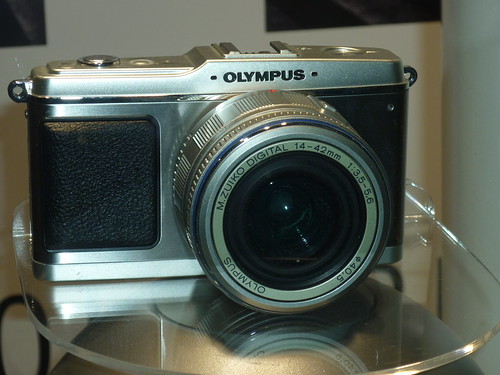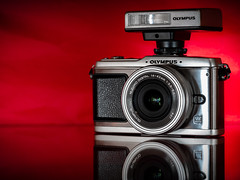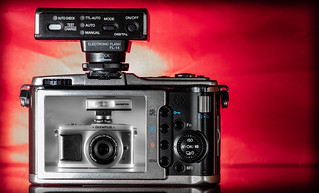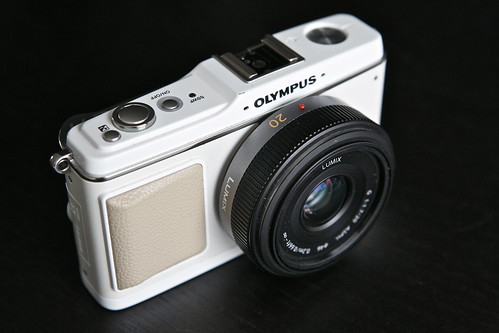Difference between revisions of "Olympus Pen E-P1"
Hanskerensky (talk | contribs) (Added authors script image uwe_kulick/5459567109/) |
m (→Links: year cat) |
||
| (15 intermediate revisions by 5 users not shown) | |||
| Line 1: | Line 1: | ||
| − | |||
{{Flickr image | {{Flickr image | ||
| image_source=http://www.flickr.com/photos/uwe_kulick/5459567109/in/pool-camerawiki/ | | image_source=http://www.flickr.com/photos/uwe_kulick/5459567109/in/pool-camerawiki/ | ||
| Line 8: | Line 7: | ||
| image_rights= wp | | image_rights= wp | ||
}} | }} | ||
| − | |||
| − | A newer [[Olympus Pen E-P2|EP-2]] model was released in 2010. | + | The '''Olympus Pen E-P1''' is a digital camera that uses the [[Micro Four Thirds]] lens mounting system. It was released in 2009. A newer [[Olympus Pen E-P2|EP-2]] model was released in 2010. |
| + | The camera uses a 12.3 megapixel 4/3" (18.00 × 13.50 mm) Live MOS Sensor. This produces images in 4032 x 3024 resolution in RAW, RAW + JPEG and JPEG formats. Video can also be captured in 1280 x 720 resoution and stored in a MJPEG formatted AVI container. There is no built-in optical viewfinder. Composing and previewing can be done with the 230,000 pixels 3 inch [[LCD]] screen. An optional VF-1 viewfinder that attaches to the [[hot shoe]] was also offered. It had bright lines suitable for 17mm lens. There is no built-in flash, but the FL-14 external shoe mounted flash was the recommended accessory. Media can be captured onto [[Secure Digital|SD /SDHC]] flash memory cards. It is powered by a BLS-1 1150 mAh Lithium-Ion rechargeable battery. | ||
| + | |||
| + | {{Flickr_image | ||
| + | |image_source= https://www.flickr.com/photos/cwhatphotos/32978788708/in/pool-camerawiki/ | ||
| + | |image= http://farm8.staticflickr.com/7831/32978788708_b9ec223315_m_d.jpg | ||
| + | |image2_source= https://www.flickr.com/photos/cwhatphotos/32978784018/in/pool-camerawiki/ | ||
| + | |image2= http://farm5.staticflickr.com/4828/32978784018_c8f70c9a24_n_d.jpg | ||
| + | |image_align= left | ||
| + | |image_text= with system flashgun FL14 | ||
| + | |image_by= CWhatPhotos | ||
| + | |image_rights= (C) | ||
| + | }} | ||
| + | {{brl}} | ||
{{Flickr_image | {{Flickr_image | ||
| − | | image_source= | + | |image_source= https://www.flickr.com/photos/95698098@N06/16757741927/in/pool-camerawiki/ |
| − | | image=http:// | + | |image= http://farm9.staticflickr.com/8697/16757741927_6a30acbc18.jpg |
| − | | image_align= | + | |image_align= left |
| − | | image_text=camera | + | |image_text= Olympus first µ4/3 [[CSC]] could take system lenses made by Panasonic,<br/>the company that made the first µ4/3 camera in 2008, the [[Panasonic Lumix DMC-G1|G1]]. |
| − | | image_by= | + | |image_by= Dirk Bruyns |
| − | }}{{br}} | + | |image_rights= wp |
| + | }} | ||
| + | |||
| + | {{br}} | ||
==Links== | ==Links== | ||
| + | *[https://www.manualslib.com/products/Olympus-E-P1-Digital-Camera-Prosumer-292641.html Olympus Pen E-P1 user manual] at [https://www.manualslib.com/ Manualslib] | ||
* [http://www.dpreview.com/reviews/olympusep1/ Olympus Pen E-P1 review] at [http://www.dpreview.com Digital Photography Review] | * [http://www.dpreview.com/reviews/olympusep1/ Olympus Pen E-P1 review] at [http://www.dpreview.com Digital Photography Review] | ||
| + | {{Camera Grand Prix}} | ||
| + | |||
[[Category:Olympus|Pen E-P1]] | [[Category:Olympus|Pen E-P1]] | ||
| + | [[Category:P|Pen E-P1 Olympus]] | ||
[[Category:Micro four-thirds]] | [[Category:Micro four-thirds]] | ||
[[Category:Japanese digital system cameras]] | [[Category:Japanese digital system cameras]] | ||
| + | [[Category: EISA]] | ||
| + | [[Category:2009]] | ||
| + | [[Category:RAW-ORF]] | ||
Latest revision as of 20:59, 8 February 2024

|
| image by Uwe Kulick (Image rights) |
The Olympus Pen E-P1 is a digital camera that uses the Micro Four Thirds lens mounting system. It was released in 2009. A newer EP-2 model was released in 2010.
The camera uses a 12.3 megapixel 4/3" (18.00 × 13.50 mm) Live MOS Sensor. This produces images in 4032 x 3024 resolution in RAW, RAW + JPEG and JPEG formats. Video can also be captured in 1280 x 720 resoution and stored in a MJPEG formatted AVI container. There is no built-in optical viewfinder. Composing and previewing can be done with the 230,000 pixels 3 inch LCD screen. An optional VF-1 viewfinder that attaches to the hot shoe was also offered. It had bright lines suitable for 17mm lens. There is no built-in flash, but the FL-14 external shoe mounted flash was the recommended accessory. Media can be captured onto SD /SDHC flash memory cards. It is powered by a BLS-1 1150 mAh Lithium-Ion rechargeable battery.
 
|
| with system flashgun FL14 images by CWhatPhotos (Image rights) |

|
| Olympus first µ4/3 CSC could take system lenses made by Panasonic, the company that made the first µ4/3 camera in 2008, the G1. image by Dirk Bruyns (Image rights) |
Links
| Japan Camera Grand Prix | |
|---|---|
| Camera of the year
1984: Nikon FA | 1985: Minolta α-7000 | 1986: Canon T90 | 1987: Canon EOS 650 | 1988: Kyocera Samurai | 1989: Nikon F4 | 1990: Canon EOS 10 | 1991: Contax RTS III | 1992: Pentax Z-1 | 1993: Canon EOS 5 | 1994: Minolta α-707si | 1995: Contax G1 | 1996: Minolta TC-1 | 1997: Nikon F5 | 1998: Pentax 645N | 1999: Minolta α-9 | 2000: Canon EOS-1V | 2001: Minolta α-7 | 2002: Canon EOS-1D | 2003: Canon EOS-1Ds | 2004: Nikon D70 | 2005: Konica Minolta α-7 Digital | 2006: Nikon D200 | 2007: Pentax K10D | 2008: Nikon D3 | 2009: Canon EOS 5D Mark II | 2010: Olympus Pen E-P1 | 2011: Pentax 645D | 2012: Nikon D800 | 2013: Sony DSC-RX1 | 2014: Nikon Df | 2015: Canon EOS 7D Mark II | 2016: Sony α7R II | 2017: Olympus OM-D E-M1 Mark II | 2018: Sony α9 | 2019: Lumix S1R | 2020: Sony α7R IV | 2021: Sony α1 | 2022: Nikon Z9 | 2023: Sony α7R V Special Prize Editor | |